 Weird Stuff
Weird Stuff  Weird Stuff
Weird Stuff  Mysteries
Mysteries 10 Tragic Disappearances and Deaths in Joshua Tree National Park
 History
History 10 Ways Childhood Really Sucked in the Old West
 Music
Music 10 Name Origins of Famous Bands from the 1990s
 Religion
Religion 10 Biggest Turnarounds by the Catholic Church
 Weird Stuff
Weird Stuff 10 Unbelievable Times Laws Had Unintended Consequences
 Humans
Humans Ten Historic Women Who Deserve Way More Credit Than They Got
 Movies and TV
Movies and TV 10 Films That Spawned Major Lawsuits
 History
History Ten Times Towns Were Wiped Off the Face of the Earth
 Creepy
Creepy 10 of the Most Disturbingly Haunted Public Houses in the UK
 Weird Stuff
Weird Stuff 10 Niche Subcultures That Are More Popular Than You Might Think
 Mysteries
Mysteries 10 Tragic Disappearances and Deaths in Joshua Tree National Park
 History
History 10 Ways Childhood Really Sucked in the Old West
Who's Behind Listverse?

Jamie Frater
Head Editor
Jamie founded Listverse due to an insatiable desire to share fascinating, obscure, and bizarre facts. He has been a guest speaker on numerous national radio and television stations and is a five time published author.
More About Us Music
Music 10 Name Origins of Famous Bands from the 1990s
 Religion
Religion 10 Biggest Turnarounds by the Catholic Church
 Weird Stuff
Weird Stuff 10 Unbelievable Times Laws Had Unintended Consequences
 Humans
Humans Ten Historic Women Who Deserve Way More Credit Than They Got
 Movies and TV
Movies and TV 10 Films That Spawned Major Lawsuits
 History
History Ten Times Towns Were Wiped Off the Face of the Earth
 Creepy
Creepy 10 of the Most Disturbingly Haunted Public Houses in the UK
10 Creepy Mysteries Of The Bennington Triangle
The Bermuda Triangle is famous for strange happenings and disappearances in the ocean nestled between Florida and Bermuda. That famous area has a smaller cousin further north, centered around Glastenbury Mountain in the southwestern part of Vermont. This mysterious area is known as the Bennington Triangle.
The Bennington Triangle has a history that predates the colonization of North America and persists to this day. It has inspired books and movies, as well as supernatural reports of Bigfoot, UFOs, and interdimensional portals. The truth of the Bennington Triangle remains unknown, but the area has mysteriously swallowed as many as 40 intrepid hikers and residents.[1]
10 Native American Warnings
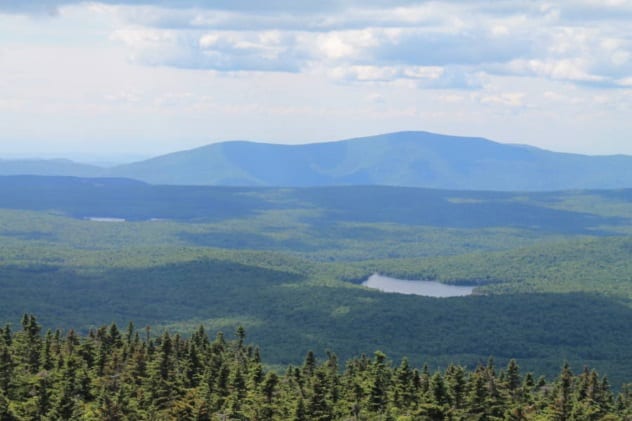
It’s stated in Joseph A. Citro’s 1996 book, Passing Strange: True Tales of New England Hauntings and Horrors, that Native Americans refused to set foot on Glastenbury Mountain unless they were burying their dead.[2] They believed that the whole mountain was cursed land because the “four winds” met there in an eternal struggle. While most refer to this as a myth, there is some truth to it. The wind pattern on Glastenbury Mountain is so erratic that weather changes suddenly, and plants grow at odd angles.
Another myth attributed to the native people of Vermont is that they believed an enchanted stone among the cairns on top of the mountain could swallow a man whole. As reported by Davy Russell in X-Project Paranormal Magazine, a person would stand on the rock to survey the area from the highest point and find themselves suddenly swallowed whole. That person would never be heard from again.
9 A Ghost Town
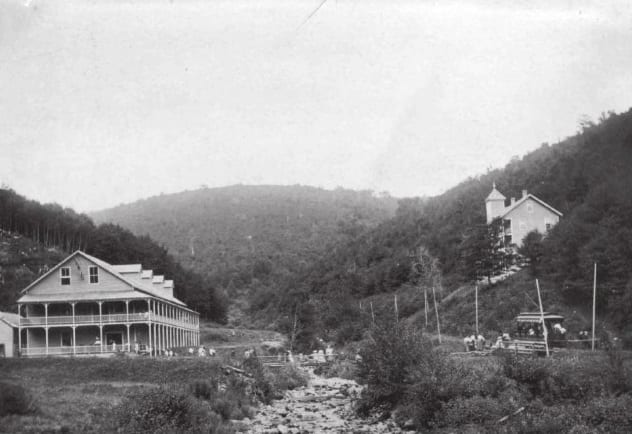
Glastenbury seems to have been slated to be a ghost town since its very first day. In 1761, Benning Wentworth drew the boundaries of the town on a map without ever stepping foot there.[3] The area had rough terrain and a very short growing season, so settling was an uphill battle all the way to the 1800s. Literally. There were technically two towns, Fayville and South Glastenbury, on either side of the mountain, but they were never connected due to the impossible incline between them.
Glastenbury was first established as a logging and mining town. Workers were brought up to log and mine coal by a railroad that climbed 14 kilometers (9 mi) at a ridiculous 76 meters (250 ft) per mile. Logs and coal were sent down the Bolles Brook, which forked near the town and flowed down the mountain. Both industries relied on finite resources that quickly dried up. In 1894, a final push was made to reinvigorate the town of Glastenbury by making it into a tourist hot spot. The simple buildings of the town were reinvented as hotels and casinos. The railroad was fitted with fashionable trolley cars. No expense was spared.
Unfortunately, the extreme logging of the past left the mountainside unprotected from soil erosion. In 1897, a massive flood destroyed much of the railway into Glastenbury. No more attempts were made to reinvent the town. People left the area to start over, leaving the town with a rapidly dwindling population. Ripley’s Believe it or Not! documented the Mattinson family in 1930. The three members of the family made up the entire town by themselves and held every office available between them. In 1937, the town was officially unincorporated. As of the 2010 census, a mere eight people lived there.
8 Strange Occurrences Since The 1800s
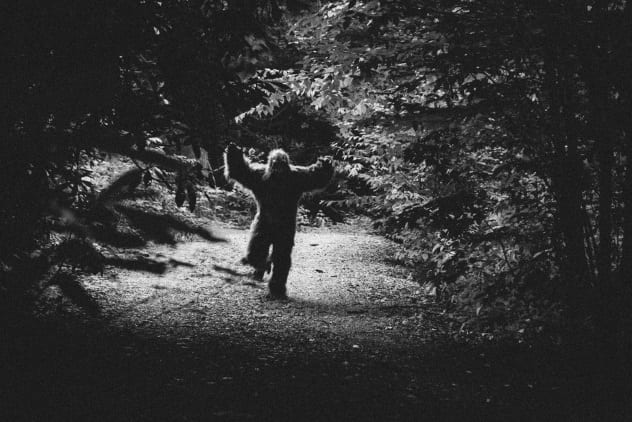
Reports of strange lights in the sky, sounds with no explanation, and odd odors on the mountain predate colonial settlements. These reports, combined with the many strange disappearances, have led to speculation about UFOs and wormholes in the area. Still, the strangest report may be the Bennington Monster. Thought to be an early Bigfoot or Sasquatch, the monster has been described as well over 1.8 meters (6 ft) tall, with hair from its head to its toes. The first sighting of the monster was reported in the early 19th century, when it rushed a stagecoach on a washed-out road. The beast knocked the stagecoach onto its side and fled into the dark with a roar. Luckily, no one was harmed.
In 1967, a somehow less pleasant monster began to appear on the mountain.[4] The wild man of Glastenbury lived in a cave near Somerset. Unfortunately for everyone, he didn’t stay there. Reports say that he would descend into nearby Glastenbury and other settlements in the Bennington Triangle to harass women. He accomplished this by pulling open his ratty coat to reveal his nude body while waving around a pistol to scare off anyone who might want to stop him. Luckily, that seems to be all he did before fleeing off back to his cave.
There were strange happenings in the Bennington Triangle that were less fantastic than a massive ape man or gun-wielding nudist as well. The conversion to a tourist town was hard on the loggers and miners of Glastenbury and Fayville. In 1892, a sawmill worker, Henry McDowell, drunkenly bludgeoned a coworker to death with a rock after he heard voices telling him to attack. He was committed to an asylum but managed to escape and vanish. Only five years after that murder, another strange one followed nearby. John Harbour was a prominent Woodford citizen who went into Bickford Hollow, just south of Glastenbury, to hunt. He was shot by persons unknown but was found with his fully loaded gun just next to him and seemed to have been dragged several yards. Those who investigated his death were left wondering why he was so easily shot with a fully loaded gun and why his assailant would bother to put the gun next to him after dragging him. This murder has gone unsolved and will likely stay that way.
7 The Disappearances
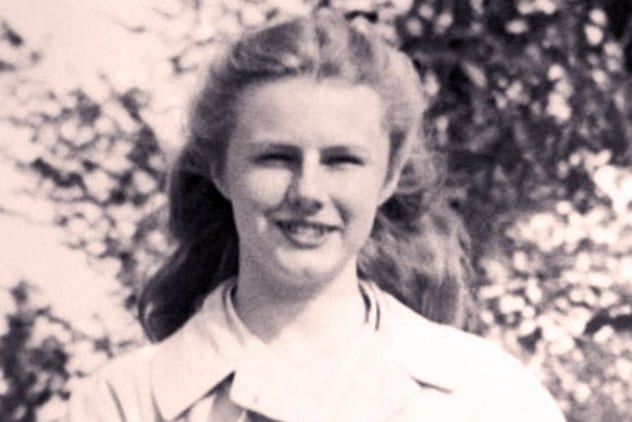
The Bennington Triangle’s most enduring unsolved mysteries are the disappearances that plagued the area from 1945 to 1950. In that five-year span, several people went missing on or near Glastenbury Mountain. The first was a 75-year-old man named Middie Rivers, who often served as a mountain guide.[5] He was leading a group back to their camp in November 1945 when he got ahead of them just enough to be out of sight. In that short time, he completely vanished. It’s unlikely that he became lost because he was highly experienced at navigating the mountain. Nonetheless, he was never seen again.
Paula Welden (pictured above), an 18-year-old college student who had recently taken up hiking, went to explore the mountain in 1946. Welden was spotted on her way by several people, including drivers who gave her rides and fellow hikers who warned her that she wasn’t dressed warmly enough to hike the mountain. Welden’s red coat made her easy to spot, but baffled searchers later couldn’t find any sign of her or her brightly colored clothes. Her case became the most famous disappearance, mostly due to the fact that it caused Vermont to found its own state police force. With no police of their own, Vermont had only one state investigator to put on the case. Police from New York and Connecticut were eventually called in by Welden’s father, but she was never recovered.
In 1949, three hunters went missing on the mountain. That same year, James E. Tetford went missing while on a bus trip from St. Albans to the town of Bennington. In 1950, eight-year-old Paul Jepson went missing from his Bennington home. Police dogs were able to trace his scent to the highway but no further. He was, coincidentally, wearing a red jacket similar to Paula Welden’s coat. That year would see the last of the disappearances with Frieda Langer. She disappeared while hiking with her cousin and friends. Her clothes had gotten wet during a hike and she went back to camp to change. When the group realized that she had never arrived, a massive search was launched. Volunteers, police, firefighters, and the military all joined together to search, but she was never found alive.
6 Remains Lost And Found

Only one body was ever recovered from the disappearances on the mountain. Frieda Langer’s body was found the following May. Search parties had previously heavily combed the field she was found in, leading authorities to speculate that there was foul play. Unfortunately, her body was too decomposed to give any insight into her cause of death.[6] The advanced decomposition only made someone’s decision to move her there more mysterious, though. The process would have likely been messy and conspicuous.
Far more odd than the discovery of Langer’s body are those that were never found at all. There is dangerous wildlife on Glastenbury Mountain, but their attacks leave behind tons of evidence. Bears don’t usually swallow a person whole. Search parties were frustrated to find no signs of the missing people whatsoever. Both Welden and Jepson were wearing bright red coats that should have been easy to spot on their own. Rivers and Langer seemed to disappear suddenly without being too far from their companions. Tetford’s case is odder still, since he disappeared from a bus. He was surrounded by witnesses but still vanished between stops.
5 A Serial Killer
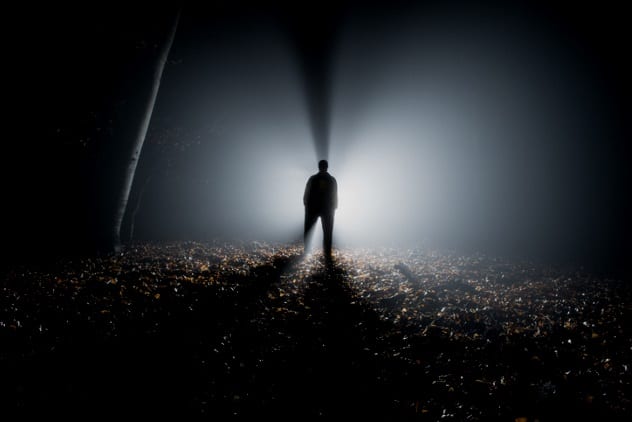
The pattern of the disappearances has led some to suggest a serial killer was responsible. All of the people who vanished did so within the winter, which suggested something other than chance was at play. The first disappearances left no trace at all, and Langer’s body was discovered in a place that had already been searched. Perhaps someone was extremely successful in abducting and killing people near the highway or on the mountainside. And, like many other killers, maybe that person succumbed to the desire to show off when they moved Langer’s body into the open. It would explain why no traces have been found of the other victims and why Paul Jepson’s trail went cold on the highway. It would even make sense in Welden’s case, since she hitchhiked to the mountain and may have accepted a ride home as well.
As appealing as this explanation is, there are a few problems. The first is that Langer and Rivers went missing on the mountain near friends. It would be extremely risky for a serial killer to abduct someone with their friends within earshot. The second problem is that the victims don’t follow a pattern. Serial killers tend to have a type. It would be extremely rare for one to pick up two elderly men, an 18-year-old woman, an eight-year-old boy, and a 53-year-old woman.[7] An opportunity killer who is fine with a wide range of victims wouldn’t fit the same profile as one who would be willing to risk grabbing Rivers or Langer near their parties.
4 Supernatural Explanations

Without the serial killer theory, the next most interesting explanations are the supernatural ones. Each has its own flavor of strangeness, and it’s hard to judge which is the wildest. High on that side of the spectrum is the man-swallowing boulder hidden among the cairns at the mountain’s peak. No one knows how the cairns were assembled there or when, but they probably don’t actually eat people. Probably.[8] However, this description of people being swallowed whole into a rock may have sparked the cross-dimensional wormhole idea. And disappearances coupled with odd lights, sounds, and odors may have led to UFO conspiracy theories in the area.
But the supernatural explanations tend to lack substance. Worse still, they’ve changed drastically over the years. Writer Joe Durwin has covered the strange folklore in his column “These Mysterious Hills” and explains how the mythos of the Triangle has changed with the times. When newspapers first reported on the Bennington Triangle phenomena, the explanation was tied into Native American legends. In the 1990s, the explanations shifted to UFOs and other ideas popularized by The X-Files. In the early 2000s, the myths circled back to Bigfoot and the Bennington Monster. Durwin isn’t overly critical of the supernatural, though. The stories are important to him. They keep the memories of those who disappeared alive and inspire people to think critically.
3 Practical Explanations
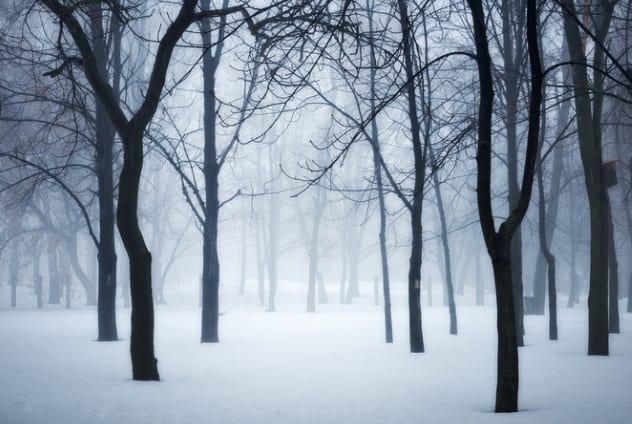
In all the research that has been done to answer the maddening questions of the Bennington Triangle, some practical answers have been found. They make sense, even if they aren’t entirely satisfying. One explanation is hypothermia. Temperatures on the mountain can drop very low, and the disappearances did all happen in the winter. When experiencing hypothermia, people might engage in terminal burrowing.[9] This is a survival behavior that drives people to find someplace small and remote to huddle. It gets people out of the wind and may provide enough warmth to help slow the process of freezing to death, but it usually kicks in too late and just makes it hard for the person to be found.
Another explanation has to do with the area’s history as a mining town. The mountainside is littered with unmarked mine shafts that may cause hikers who go off-trail to plummet to their deaths. Both of these can explain why the missing people were never found. One more complicating factor is the odd wind pattern on the mountain. Most places have a wind pattern that influences how plants grow. We don’t consciously acknowledge it, but this pattern of growth is one of the ways we orient ourselves when outdoors. Glastenbury Mountain has no consistent wind pattern, so plants grow in odd ways. Many modern hikers have had difficulty navigating the mountain for this reason, and it is the basis for the Native American myth about the four winds.
Some of these help to explain why the missing people were never found, but there are still loose ends. If the people perished from hypothermia or a fall, why was Langer moved back into the open months later, and why did Jepson’s trail end at the highway? Maybe the most practical answer is that not all five of the Bennington cluster died in the same way. Some may have met with a killer, while others burrowed or fell. But, if so, why did the disappearances span only five years and stop so abruptly?
2 Modern Reports
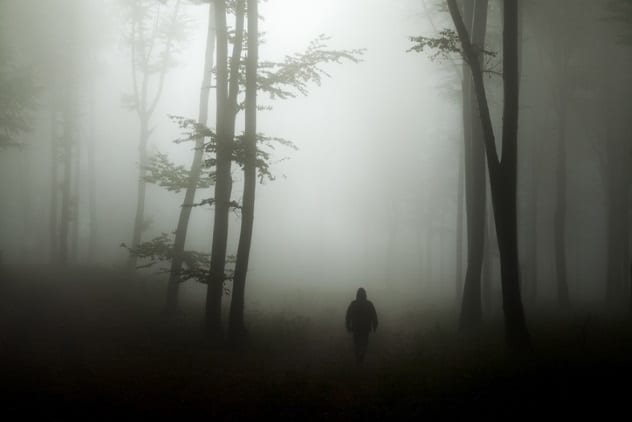
Some adventurous souls who’ve heard the rumors have set out to explore the trail infamous for the five-year period of disappearances. One such adventurer is Chad Abramovich of the website Obscure Vermont. He reported on a trip taken to the mountain, saying, “Myself and a few friends departed in his pickup truck and drove up the bumpy forest road into a strange clearing in the middle of the hills. Here, underneath summer humidity, we found old cellar holes almost entirelly [sic] hidden by tall grasses, beneath the shade of gnarled apple trees.”
Shortly after this, Abramovich and his group experienced a sudden, drastic change in the weather. It was a sunny July afternoon when they started, but a torrential thunderstorm quickly appeared. The group was stranded for some time but finally managed to make it back to the flats. When they escaped the downpour, they found that the surrounding area was bone-dry. Locals later confirmed that no thunderstorm had passed through their area.
Robert Singley, a music composition teacher at Bennington College and an experienced hiker, became lost on the mountain in 2008.[10] He took a trail he knew well to nearby Bald Mountain and then used the same trail to go back. However, the well-known trail didn’t lead where it should have. According to Singley, he walked 8 kilometers (5 mi) before realizing that he should have reached his car already. Just as he became concerned, a heavy fog rolled in, and the whole trail became hopelessly dark. He went to a maple tree that he felt called to him from the fog and tried to start a fire. Every stick he reached for turned out to be an animal bone. This would have distressed most people, but Singley was only upset about his fiancee. He imagined she was worried sick. He finally managed to light a fire and huddled by it through the night. In the morning, he found that he had somehow ended up on the other side of the ridge from his car. Luckily, he made it back to tell the tale.
1 A Popular Trail For Unwitting Hikers
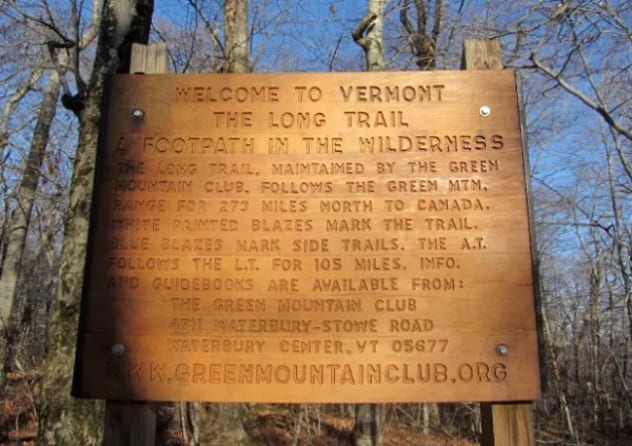
Dedicated hikers tend to seek out challenging trails, like the Long Trail that spans 439 kilometers (273 mi) through Vermont and ends at the edge of Canada. If taken in one go, the Long Trail lives up to its name. It takes from two to four weeks to complete the entire trek. This practice is known as thru-hiking. Hikers tend to plan their trips ahead of time, marking out places to stay and refuel on their maps. They tend to pick their time of year carefully, avoiding the snow of winter and the mudslides of summer. One thing that hikers usually don’t know about at all is the Bennington Triangle, which overlaps the Long Trail.
The Green Mountain Club finished expanding the trail in 1930, and it still maintains the trail and mentors hikers who aim to thru-hike there. Many guides exist for the Long Trail. Advice is abundant. Trail mentors advise bug netting to avoid black fly bites, carrying as little gear as possible, and making sure to bring a water filter. The advice is good and is specific to this trail, which has plenty of water sources and access to nearby towns if needed.
However, there is no mention of monsters or UFOs. There aren’t even mentions of the more realistic threats of mine shafts and hidden cellars. One guide even encourages hitchhiking from the trail into towns for supplies.[11] It seems like the infamous five years of disappearances have been all but forgotten by the very people who have the most to fear on Glastenbury Mountain. With people unaware of the terrain’s dangers and happily hopping into strangers’ cars, the disappearances may not be over after all.
Renee is an Atlanta-based graphic designer who enjoys writing articles.
Read about more mysterious areas filled with paranormal reports on 10 Places As Mysterious As The Bermuda Triangle and 10 Truly Bizarre Incidents From The Bass Strait Triangle.








